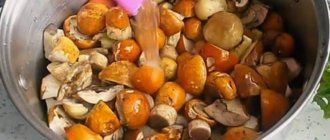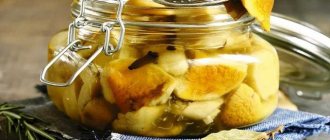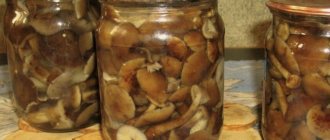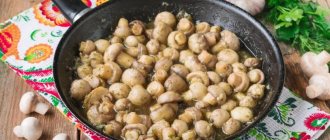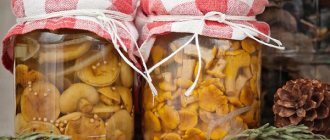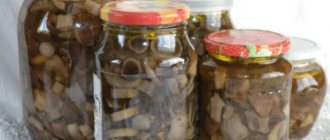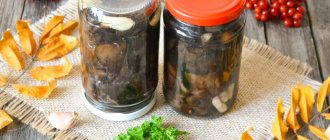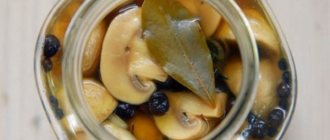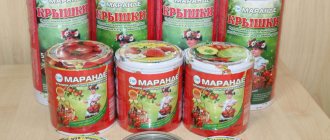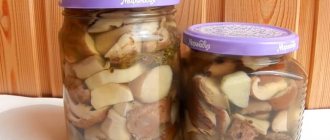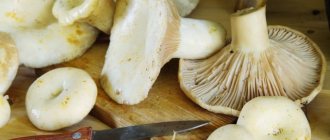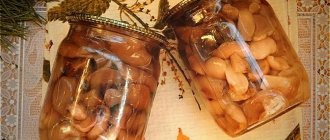It is always very simple with boletuses, because they can be sent for any processing process: boiling, pickling, salting, frying, baking, freezing, drying, etc. In any form, these mushrooms turn out to be very tasty and retain their beneficial substances, even despite duration of heat treatment. If we talk about boletuses stored for the winter, then we need to try to carry out the initial processing correctly. After all, every housewife knows that any preservation can become unusable if generally accepted recommendations for preparing products are not followed. In addition, it is necessary to pay special attention to the heat treatment of the dishes in which the fruiting bodies will be prepared and stored. Each housewife chooses a convenient method of sterilization independently.
How can you prepare boletus mushrooms for the winter?
First of all, the brought mushroom harvest is sorted out: beautiful and strong specimens are left for salting and pickling, broken and ugly specimens are used for frying and mushroom spawn, and those damaged by worms and rot are thrown away.
Boletuses cannot be soaked, as their spongy structure strongly absorbs moisture. It is better to clean them with a kitchen sponge, wiping the surfaces of the caps, and then remove the lower parts of the legs and heavily soiled areas with a knife. After which they need to be thoroughly rinsed with water or held over steam for a few seconds.
In most cases, the fruiting bodies must first be boiled for 30-35 minutes in salted water, and then begin the recipes. An exception is the cold method of pickling, where mushrooms are not subjected to heat treatment, but it is used quite rarely.
Many approach boletus recipes for the winter with creative thinking, adding various ingredients of their own or simply adjusting their quantities to their taste. And those who do not like experiments always turn to culinary sites in search of the best “mushroom” recipe. If a good forest harvest is brought home to you, then you have the opportunity to “go wild”, choosing several processing methods at once. This article presents 13 recipes that allow you to prepare boletus for the winter in the best possible way.
Preparing mushrooms for preservation
Regardless of the recipe, the preparation of boletus is the same. Initially, they should be sorted out: spoiled specimens are unsuitable for pickling. Then the mushrooms are briefly filled with water: this will remove all debris, dirt, and insects.
Next comes the cleaning process, this must be done carefully, without leaving anything unnecessary. After cleaning, the mushrooms are washed well with running water.
Mushroom stems are cut off and cooked separately because their structure is denser than the caps. They can be prepared in different ways: dried, fried, boiled.
Recipe for preparing boletus mushrooms for the winter by hot salting
Boletuses, prepared for the winter by hot salting, will “prove” themselves on the table as a favorite snack for all holidays and meals. It is prepared with preliminary boiling; this is precisely the method of hot pickling.
- Main product – 3 kg;
- Table salt – 120-150 g;
- Cloves – 4-5 buds;
- Black pepper – 15-20 peas;
- Bay leaf – 4 pcs.;
- Cold boiled water – 1 tbsp.;
- Garlic – 3-5 cloves (or to taste);
- Currant/cherry leaves.
The recipe for preparing boletus mushrooms for the winter is divided into stages, including cleaning and boiling.
- The fruiting bodies, cleared of dirt, are cut into pieces if necessary. The cut size is medium or even large, as the mushrooms are boiled down.
- Immerse in a boiling container, fill with water and add a pinch of citric acid, this will help the mushrooms retain their color.
- Place on high heat and bring to a boil. At this time, foam will begin to appear on the surface, which must be removed as often as possible.
- Then reduce the heat intensity and cook the main ingredient for 25-30 minutes, continuing to remove the resulting foam.
- The finished boletuses are transferred to a colander, washed and left to drain.
- At this time, pour boiling water over fresh currant leaves and wipe them dry.
- Cut the garlic into slices and prepare clean, dry dishes for pickling.
- Do they put it on the bottom? part of fresh leaves, 1 bay leaf, 1 clove bud and 40-50 g of salt.
- Spread a layer of mushrooms about 5 cm high on a bed of spices, place some garlic on top and repeat the procedure with salt, bay leaf and cloves.
- Similarly, fill the container with all the mushrooms, cover them with the remaining leaves and pour in 1 tbsp. water.
- Cover with clean gauze and then with a plate whose diameter is smaller than the diameter of the pickling dish.
- They put the oppression on, take it to the basement and, while waiting for the final result, begin counting down the time. After 15 days, you can take the first sample from the snack.
Preservation: methods and recipes
After the preparatory work has been completed, you can begin harvesting chanterelles for the winter. Chanterelles are preserved by salting, marinating, and frying mushrooms. As a result, you will get delicious and varied dishes.
Pickling chanterelles
Salted mushrooms are the best winter snack. Chanterelles can be pickled cold or hot. The recipes are quite simple.
Chanterelles, cold-salted
Cold method: this will require 1.5 kg of fresh mushrooms, vegetable oil, dill, garlic (3 heads) and salt.
- pour boiling water over the dill and place it in sterile containers (jars or pans);
- Place the prepared and cooled mushrooms in layers, between which there is garlic, cut into slices, and salt;
- Garlic and dill are placed on the last (top) layer;
- During the day, the containers remain under pressure in the refrigerator;
- then pour warm vegetable oil into each container so that it completely covers the mushrooms;
- close the lids and put them in a cool place;
- the workpiece is completed. Serve with onions and fried or boiled potatoes.
Canning chanterelles using the hot method
Hot method. For this method you will need 1 kg of chanterelles, 8 dried spiced cloves, 8 bay leaves, 4 tsp. salt, 6 cloves of garlic and allspice.
- Dip the prepared chanterelles into boiling water and add 1 tsp. salts and all spices;
- cook the mushrooms over medium heat for 5-7 minutes, then place in an enamel bowl, sprinkle with salt, garlic and fill with brine;
- put under pressure in a cool place;
- the next day the dish is ready to eat;
- To enjoy the dish all winter, you need to boil it for 10-15 minutes, put it in sterilized jars and roll it up.
Pickling chanterelles
These recipes differ from pickling in the presence of vinegar in the brine, but this does not make the mushrooms any less tasty. As an example, we will describe the simplest recipes.
Marinating is an equally popular way of preserving chanterelles.
Chanterelles marinated with onions and garlic:
- chanterelles (1 kg);
- vinegar (200 ml);
- garlic (4 cloves);
- onions (2 heads);
- bay leaf (4-5 pcs.);
- allspice (7-9 pcs.);
- sugar (2 tsp);
- salt (3 tsp).
For the marinade, mix vinegar and 500 ml of water, add spices and boil for 5-7 minutes. Cut the onion and garlic cloves into 4 parts. Place the prepared mushrooms in sterile jars and fill with marinade. Wait 5-10 minutes, pour the marinade back into the pan and boil it for 2 minutes. Pour it over the mushrooms in the jars again, close the lids and roll up. The workpiece is cooled upside down at room temperature.
Preparations in jarsImportant! To keep the chanterelle preparation all winter, keep it in a cool place (cellar or refrigerator).
Marinated chanterelles with lemon:
- chanterelles (1 kg);
- vinegar 9% (200 ml);
- vegetable oil (3-4 tbsp);
- lemon (2 pcs.);
- spicy cloves (3-4 pcs.);
- water (3 l);
- bay leaf (3-4 pcs.);
- black and allspice (4-5 pcs.);
- salt.
Pour boiling water over the prepared mushrooms, add salt and the juice of two lemons. Place on the fire and bring to a boil. Cook over low heat for 10-15 minutes, stirring all the time and removing foam. Drain the water and prepare the marinade: add vinegar and all the spices to 200 ml of water, pour in the oil and cook for 5 minutes, strain.
Lemon juice gives mushrooms a piquant taste
Pour the marinade over the mushrooms and simmer again over low heat for 15-20 minutes. Place in sterile jars and seal. This preparation is stored for a long time and has an unusual spicy sour taste.
Preservation of fried mushrooms
Chanterelles are one of the few mushrooms that can be prepared fried. You can also roll up simply fried foods; the most important thing here is to maintain proportion and sterility. Preparing fried chanterelles for the winter involves very simple recipes.
Fried chanterelles - a fully prepared canned dish
Fried chanterelles with butter for the winter:
- chanterelles (1 kg);
- onions (2-3 pcs.);
- vegetable oil (for frying onions and mushrooms);
- butter (250-300 g);
- salt, spices (to taste).
Fry the prepared mushrooms in a frying pan with vegetable oil. The onion must be fried separately until golden brown. Next, mix the onions with mushrooms and add spices and salt to taste. Pour a little melted butter into the bottom of a sterile jar. Then layer onions and mushrooms. The final layer should be a generous amount of butter, which will fill the voids and coat the mushrooms. The jars are rolled up and cooled. The preparation is stored in the refrigerator.
The most important thing when canning fried mushrooms is to maintain sterility
How to cook boletus mushrooms for the winter in a cold way
Salting boletus mushrooms for the winter also involves using the cold method. It is not taken up as often as hot salting, but, nevertheless, it is not ignored. Many chefs note that the mushrooms have a rich forest taste and aroma.
- Boletus – 4 kg;
- Salt (non-iodized) – 200 g;
- Oak/currant/cherry/grape leaves;
- Bay leaf and clove buds - 5-6 pcs.;
- Fresh dill – 2 bunches.
The recipe with photo will introduce you to the peculiarities of salting boletus for the winter.
Since cold salting eliminates pre-boiling the mushrooms, it is very important to allocate enough time and effort to thoroughly clean them of all kinds of debris.
After cleaning, the boletus mushrooms need to be washed thoroughly and left to drain.
In the meantime, clean fresh leaves should be placed in the prepared container in which the product will be salted. Then add 40-50 g of salt and a certain amount of chopped dill, as well as spices.
Place the mushrooms in layers, each of which must be sprinkled with spices. The amount of salt, dill, bay leaf and cloves must be calculated so that there is enough for all layers. The top layer should be covered with fresh leaves.
Place a plate or other clean surface and place a weight on it.
Send to a cool room and check the workpiece after 5-6 days. You will see that there is a lot of liquid in the container, and the fruiting bodies themselves have settled under pressure. Then you can add a new portion of fruiting bodies and spices, also arranging them in layers. If little juice comes out, add some cold boiled water. After 40-50 days, the snack will be completely ready for consumption.
Storage and use
Store jars of pickled mushrooms in the refrigerator or in a cool place at a temperature no higher than 8 degrees. Mushrooms are ready to eat after 30 days.
You can make a delicious appetizer for the New Year's table from pickled boletuses. Wash the mushrooms, place in a colander, add finely chopped onions, pour in sunflower oil and serve.
Unrefined oil gives a unique taste and aroma. Mushrooms can be seasoned with dill, green onions, garlic and sour cream.
A delicious lean filling for pies and pancakes is prepared from pickled boletuses.
How to pickle boletus mushrooms in jars for the winter
Many people decide to pickle boletus in jars for the winter - how to do this? I must say that this is very convenient, especially when you don’t have the appropriate utensils at hand - enameled, ceramic or wooden.
- Boiled boletus – 3 kg;
- Salt – 120-140 g (40-45 g per 1 kg of mushrooms);
- Garlic – 4 cloves;
- Currant leaves;
- Bay leaf – 3 pcs.;
- Carnation buds – 3 pcs.;
- Lemon acid - ? tsp;
- Black pepper grains – 10 pcs.
A step-by-step description will show how you can pickle boletus mushrooms in jars for the winter.
- Place the boiled mushrooms in a deep non-metallic container.
- Wash and dry the currant leaves, cut the garlic into slices or cubes.
- Send salt, pepper, citric acid, garlic, cloves and bay leaves to the fruiting bodies.
- Stir and set aside, and in the meantime sterilize the jars and nylon lids.
- Place currant leaves on the bottom of each jar and fill them with the mixture with mushrooms and spices.
- Pour the juice extracted from the mushrooms and press the mass into the jars with your hands.
- You can pour 0.5 tbsp into each. cold boiled water.
- Close the lids, take them to the basement and wait about 15 days to get the desired snack.
Useful tips
After the water boils and the foam rises to the surface, it must be removed, since forest debris such as pine needles and leaves float up with it. If you don't do this, the marinade will turn out cloudy.- Buy a tablespoon with holes in the store and use it to skim off the foam when cooking mushrooms. It is inexpensive and very convenient.
- Boletuses can not only be pickled, but also salted.
- If it is important that the marinade is transparent and light, add a pinch of citric acid to the jar.
- If you want to give the mushrooms an original flavor, add 6-8 juniper berries to the marinade.
- During Lent, pickled boletuses can be an excellent filling for pies with rice, onions, eggs, or an excellent snack with a variety of ingredients.
- Jars of pickled mushrooms are best stored in a cool place, at a temperature no higher than 8 degrees. The boletus will be completely ready in 30 days.
- Mushrooms tolerate heat treatment well. Their fruiting bodies do not disintegrate after cooking, as sometimes with agaric mushrooms.
- You can pour hot vegetable oil into the boletus in a jar. This prevents the mushrooms from spoiling and makes the marinade softer and more satisfying.
- The fruiting bodies can be washed well with a new dishwashing sponge.
- Boletuses need to be cooked very quickly after picking. If they sit for a while, they will begin to darken.
- Mushrooms are considered ready when they sink to the bottom of the pan.
- Very often, beautiful red and orange caps are marinated separately from the legs, supposedly in order to make the preparations softer.
Boletuses, salted for the winter with horseradish
To prepare boletus mushrooms for the winter by pickling, horseradish leaves and roots are often used.
This ingredient has essential and mustard oils, which give the finished snack a characteristic spicy taste.
- Main product (boiled) – 5 kg;
- Salt – 200-250 g;
- Horseradish root – 3 pcs.;
- Young horseradish leaves – 5-7 pcs.;
- Dill (greens) – 2 bunches;
- Black pepper (peas) – 20-25 pcs.;
- Garlic – 5 cloves.
How to pickle boletus mushrooms for the winter with the addition of horseradish?
- Cut the garlic into slices, and grate the horseradish root on a fine grater. It should be noted that the amount of these spices can be adjusted to your taste.
- Finely chop the dill, wash and dry the horseradish leaves.
- Place all the ingredients in one common container and mix everything thoroughly.
- Cover with horseradish leaves and place a plate on top on which we place the weight.
- We take it out to a cool room to salt, periodically inspecting the workpiece for the presence of mold and secreted juice. If there is not enough liquid, add some cold boiled water.
- After 2 weeks we take the first sample, the taste of the snack will show whether it is ready or not.
Selecting and preparing the necessary ingredients
Mushrooms should be selected young (not overripe), strong, whole (not crushed), without signs of worms. At the next stage, brush off the soil/sand, remove leaves, various types of debris, and insects. Then cut off the tips of the legs and roots (stumps), sort small and large boletuses by size. Immediately rinse mushrooms prepared for cooking with clean water and allow to dry.
It is recommended to use soft water for rinsing
What else can you do with boletus for the winter?
Salted aspen boletuses, prepared for the winter with the addition of onions, can be seen on almost every table. And with a glass of 40-degree alcohol, such a snack is simply amazing to savor!
- Prepared mushrooms – 3.5 kg (weight indicated in boiled form);
- Onions – 2 large pieces;
- Green onions – 1 medium bunch;
- Dill seeds – 1.5 tsp;
- Salt (non-iodized) – 150 g;
- Black, allspice and white pepper grains – 5 pcs.;
- Currant leaves – 10-15 pcs.;
- Cloves and bay leaves - 2 pcs.;
A recipe with a step-by-step description will show you how to cook boletus for the winter?
- Onions are cut into rings, half rings or cubes, green onion feathers are finely crumbled.
- At the bottom of a wooden, enamel, glass or ceramic container for pickling, a pillow of currant leaves is made. These leaves contain enzymes that give the mushrooms their springiness and crunchy texture.
- Onions and some of the spices mentioned in the list are laid out on top.
- Boiled boletuses are laid in layers, between which you need to distribute all the spices from the list, including chopped green onions.
- Cover the top with clean gauze and press down with any flat plate.
- It is pressed down with a load - a stone or a container filled with water.
- It is taken to the basement, where the salting process will continue for about 2 weeks.
How to clean salting racks?
This mushroom loves sandy soil and silica. Grows from late summer to late autumn. Most often found under birch trees and in areas with deciduous forest. Almost never found in coniferous forests. The stem of the mushroom is quite short and dense. The hat is covered with hairs. In this case, the color of the membranes under the cap is yellow or milky, regardless of the color of the mushroom.
It is worth noting that the taste of the mushroom is quite specific. In its raw form, there is a bitterness that disappears during heat treatment. In addition, during marinating and frying, the volushka acquires a pleasant earthy flavor.
There is no need to scrape off the film, since it is not dense. During cleaning, the fungi are simply washed with a huge amount of water, after which debris and remaining soil are removed with a toothbrush.
How to clean salting racks?
How to salt boletus with mustard for the winter in jars
This recipe for preparing boletus mushrooms for the winter suggests using an unusual “cold-hot” method.
- Main product – 3 kg;
- Salt – 130 g;
- Mustard seeds – 1 tbsp. l.;
- Garlic – 8-10 cloves;
- Vinegar 9%;
- Bay leaf – 5 pcs.;
- Dill – 3 umbrellas.
To make boletus harvesting appetizing for the winter, you should use some simple recommendations.
- Thoroughly peeled and washed mushrooms are placed in layers, sprinkled with salt, as well as all the spices and spices specified in the recipe, except vinegar. It is recommended to grind the mustard seeds in a coffee grinder, but you can use it just like that.
- They compact and press down on top with oppression, and take it out to the basement for a week and a half.
- The juice that has separated from the fruiting bodies is drained, and the fruiting bodies themselves are washed with cold water.
- Prepare fresh brine: take 1.5 tbsp per 1 liter of water. l. salt.
- The mushrooms are boiled in fresh brine for 5-7 minutes and placed separately in sterilized jars.
- The brine is allowed to boil again, poured into the jars up to the neck, without adding 2 cm to the top.
- Pour 2.5 tbsp into each jar. l. vinegar and place in a pan with hot water.
- Sterilize for 30-40 minutes over low heat, roll up the lids and insulate with an old blanket.
- After cooling, take it to the cellar and store for no more than 10 months.
Cooking steps
Picking mushrooms is a useful activity; it will help you unwind, and will also keep your body in good shape, because walks in the fresh air in the forest, and also physical exercise, are companions to a healthy lifestyle.
Therefore, we collect mushrooms ourselves and prepare them for subsequent processing. To do this, wash both porcini mushrooms and boletus thoroughly and several times in cold water. We cut large specimens into pieces, and leave small ones as is. We will also prepare all the necessary seasonings and spices for marinating the mushrooms, because without them the taste of the marinade will turn out bland.
Separately or together, pour the prepared mushrooms into a deep pan. By the way, rinse the pan first and leave it slightly damp.
Pour a small amount of salt into the pan and put the mushrooms on the fire. Constantly stir the future marinated appetizer and wait until the ingredients release their juice. Cook the mushrooms for 10-15 minutes and simultaneously skim off the foam that will form on the surface of the mushrooms.
Cook the mushrooms until they stop producing white foam, then add black pepper and bay leaf to them.
We also put the required amount of allspice and cloves into the pan along with salt and sugar: the latter ingredients are most often adjusted to taste. Cook the mushrooms for another 5 minutes along with all the added spices and spices.
After the specified time has passed, add vinegar in the required volume to the pan with mushrooms. Cook the mushrooms for another 2-3 minutes, and then begin to pour the preparation into pre-sterilized small jars. We screw or seal the jars with lids and turn them upside down.
The mushrooms cool down under a warm blanket, after which they can be hidden in a cellar or other dark and cool place. Delicious homemade pickled boletuses and porcini mushrooms are ready for the winter!
Bon appetit!
I again dedicate this post to mushrooms, or more precisely, how to make preparations for the winter and dishes from the relatives of the porcini mushroom - boletus and boletus, these mushrooms belong to the genus obabok. The photo shows that outwardly they differ only in color, the structure, recipes for cooking, salting and pickling boletus and boletus are similar. When cooked, the boletus darkens when cut, which is why this mushroom is called black. But the boletus is called the red mushroom because of its beautiful cap. It is believed that the benefits of boletus mushrooms are that they reduce cholesterol levels in the blood and cleanse the blood, but boletus mushrooms are useful for kidney diseases. These mushrooms contain a large amount of protein and dietary fiber, working in our body as a vacuum cleaner and sorbent. Therefore, you should remember that you need to collect any mushrooms away from roads and industrial areas. It is better not to pick old, overripe and worm-eaten mushrooms into your basket.
This recipe is very simple, although it is intended for future use. Mushrooms - boletus, boletus and boletus are simply boiled; at the end of cooking, vinegar and seasonings are added to them. I will explain in detail how and how much you need to cook boletus or boletus and show it in the photo in this recipe.
For the recipe for pickled boletus and boletus you will need:
Actually, the forest mushrooms themselves,
Marinade:
- for 1 liter of water
- 2 tablespoons sugar,
- 2 tablespoons (heaped) salt,
- 3 teaspoons of vinegar essence (or 1 glass of 6% table vinegar),
- 2-3 bay leaves,
- 10 black peppercorns,
- 3-5 buds of cloves,
- Cinnamon - at your discretion.
Recently I tried adding 2-3 cloves of garlic when marinating boletus and boletus mushrooms, I really liked the taste of the mushrooms!
If you use vinegar in the marinade rather than vinegar essence, the amount of water should be reduced by a glass
Attention: when marinating and salting mushrooms, do not use iodized salt!
How to pickle boletus and boletus mushrooms:
How to clean boletus and aspen mushrooms?
They usually select strong, young mushrooms, without wormholes.
Some people think that you need to remove the skin from the cap and the scales from the stem from boletus and boletus.
Personally, I clean the mushrooms from small twigs and leaves, cut off and clean the dirty, damaged parts with a knife, fill them with water so that the dirt falls off faster (you can use a small brush to clean the mushrooms). And then I wash the mushrooms several times in running water.
Boletus fried for the winter: a step-by-step recipe for cooking mushrooms
There are recipes for fried boletus prepared for the winter. Such preservation will certainly help you out in the cold season, especially during the unexpected arrival of guests.
- Prepared boletuses (preferably boiled);
- Salt;
- Vegetable oil, butter.
A step-by-step recipe for fried boletus for storing for the winter will help anyone, even a novice housewife, cope with its preparation.
- Place fresh or boiled fruit bodies in a hot, dry frying pan and fry until the liquid evaporates.
- Pour in enough vegetable oil so that the level covers the mushrooms and they float freely in it. Oil can be replaced with rendered lard or other animal fat.
- Fry the boletus in oil for about 20 minutes, add salt at the end.
- Prepare jars and lids that need to be sterilized in advance.
- Place mushrooms in each container, leaving a space of 2-3 cm high at the top.
- Fill the void in the jars with the remaining fat, and if there is not enough of it, then heat a new portion, and then fill it.
- Roll up or close with tight nylon lids, leave to cool, covered with a warm cloth.
- Send the workpiece to be stored in the basement until the time when it becomes necessary to use it.
Boletus fried with vinegar
What else can you do with boletus mushrooms for the winter by frying them? Many housewives add table vinegar, which is one of the best preservatives and allows the product to be stored for a long time.
- Boiled mushrooms – 3 kg;
- Vegetable oil – 2 tbsp.;
- Vinegar 9% - 5-6 tbsp. l.;
- Salt;
- Fresh dill – 1 bunch;
- Garlic – 5 cloves.
The recipe for cooking boletus fried for the winter is divided into stages:
- Place the boiled fruit bodies in a dry, hot frying pan and fry over intense heat until the moisture has evaporated.
- Add 1 tbsp. oil and continue frying for 10 minutes, reducing heat to medium.
- Finely chop the garlic and dill and mix together.
- Remove the mushrooms from the frying pan and place them in sterilized jars, laying them out in layers of 4-5 cm.
- We add garlic and dill to each layer, and do not add the mushrooms themselves to the top of the jar, about 3 cm.
- Add the remaining oil to the pan, then add salt to taste and add vinegar.
- Stir, bring the mixture to a boil and pour an equal amount into each jar.
- We close with tight nylon lids, cool and take the workpiece for storage in the basement or place it on the refrigerator shelf.
How to cook
- After collecting mushrooms, they need to be sorted - some should be sent for frying, others - for pickling, and the most beautiful and elastic ones - for pickling. Various types of mushrooms are suitable for marinating according to this recipe - these can be boletus, aspen, porcini mushrooms, butter mushrooms, fly mushrooms, Polish mushrooms and others. Initially, they must be cleaned of foliage, needles, and grass stuck to the caps, and the legs must be cleaned of soil and sand. This can be done under running tap water or by soaking the mushrooms in a bowl of water for an hour and then rinsing.
- Next, cut the mushrooms. The pieces should be quite large, as they say, so that they are pleasant to put in your mouth. Leave small specimens whole.
- When chopping mushrooms, I advise you to adhere to the following rules: cut large diameter stems into narrow stumps, thin ones into cylinders up to 5 cm long.
- Cut small caps in half, medium-sized ones into 4 pieces, large ones first in half and then into triangular sectors, but leave the smallest ones as is.
- Place the chopped boletus and boletus in a large saucepan, I got a full 5-liter one.
- Pour filtered water over the mushrooms (no need to cover them completely), cover with a lid and place over medium heat. Bring to a boil, making sure that the mushrooms do not “escape”, remove the lid and use a tablespoon to remove the foam.
- Add 2 tbsp. l. salt and boil for 20 minutes. Then drain in a colander and let the water drain completely. Prepare the jars. Wash them with soda and sterilize over steam for 5 minutes. To prepare the marinade, measure the required amount of water into a saucepan and add salt, sugar, allspice and peppercorns, cloves and bay leaves.
- Cook the marinade for 10-15 minutes after boiling over low heat. After this, add vinegar. Place aspen and boletus mushrooms in jars to fill 2/3 of the volume.
- Pour the hot marinade over the mushrooms and stir until the marinade is well distributed. Add 2 tbsp on top. spoons of vegetable oil.
- Place the lids in slightly cooled boiling water and close the jars. Use plastic or screw-on lids. Cover the jars with a towel or blanket and leave to cool.
Note to the owner:
- From the above quantity of fresh boletus and boletus, I got 4 cans of 0.7 l each and 4 cans of 0.5 l each.
- It is advisable to store pickled mushrooms in the refrigerator, but you can store them in some other cool, dark, dry place.
- After a month, you can eat mushrooms. During this time, they will brew, acquire a wonderful taste and aroma and will be ready to delight you and your loved ones.
With the onset of autumn, the time for winter preparations does not end. It's time for mushrooms. They can be salted, dried, frozen, pasteurized, and fried. And, of course, marinate. Anyone who doesn’t know how boletus, boletus and other mushrooms are pickled should not worry. The recipes for preparing this snack for the winter do not include anything complicated.
There are differences in the process of pickling different mushrooms, but they are minor. Therefore, it is easy to learn this business. If you follow the advice of experienced chefs, pickled boletus will turn out no worse than butter. Moreover, no matter how much you prepare mushrooms for the winter, everything is eaten without a trace!
The pickling of boletuses, regardless of the recipe, begins with preparation for preservation. They are sorted, selecting small ones, and filled with water for a short time to remove debris, dirt, and insects.
There is no need to dry it, but a good cleaning is a must. If you cook boletus mushrooms, do the same.
Wash thoroughly in running water. If you don’t do everything correctly at this stage, even the best one will not help, since they will have to be reprocessed, pouring out the entire marinade.
The structure of mushroom stems is denser than the caps, so they are separated and cooked separately. You can dry, boil, fry - your choice.
Whatever method of pickling boletus for the winter is chosen, they are first boiled. You need to immerse the mushrooms in already boiling water. Cook for 15 minutes, no more, otherwise the marinade will become cloudy and dark. It is also impossible not to overcook. Boletus and boletus, preserved half-raw, quickly turn sour.
It is not advisable to put different mushrooms in one container. Tender boletus mushrooms boiled with boletus mushrooms turn into porridge, and the oily marinade for boletus mushrooms takes on an unappetizing hue. Jars with mushrooms for the winter must be filled completely with marinade filling. Otherwise, mold will form on the surface of the brine. In order for the preserved food to be stored for a long time, it is not allowed to add water to the prepared marinade.
Preparing frozen boletus for the winter
Harvesting boletus mushrooms for the winter, in addition to preserving them in jars, also involves freezing. Many housewives successfully use this method.
- Boiled boletus;
- Vegetable oil - for frying.
So, a step-by-step description will show what can be done with boletus for the winter.
- Fry the mushrooms over high heat until the liquid evaporates.
- Add a little oil and continue to fry until done, but over less intense heat.
- Once cooled, the finished fruiting bodies are transferred to plastic containers and stored in the freezer.
The advantage of this preparation is that at any time of the year you have an almost finished product at hand, which only needs to be heated and served in combination with various dishes.
Features and benefits of mushrooms
Boletuses are considered one of the most valuable and useful mushrooms. It is recommended for people who are on a diet to add them to their diet. They will also be indispensable for preventive purposes, for kidney diseases or nervous system disorders. They are no less valued for vegetarian nutrition.
Thanks to its rich component composition, which includes potassium, phosphorus, protein and iron, this forest product helps reduce “bad” cholesterol and is also able to purify the blood.
These mushrooms are difficult to confuse with any others. The color of the cap of these forest dwellers resembles the color of autumn leaves, so in common people you can hear the second name for boletuses - “redheads”. This product is also low in calories - only 22 kilocalories per 100 grams. Compared to other mushrooms, boletuses are most effective at absorbing radionuclides, the high concentrations of which cause cancer.
In terms of nutritional value and amino acid content, this forest product can be compared to meat products. A high content of useful minerals is noted in the caps.
If you add these fruits to your diet, you can improve the condition of the following disorders:
- An anemic disorder caused by a lack of iron in the body.
- Inflammatory process.
- Deep cuts and wounds that need rapid tissue regeneration.
- Rehabilitation after severe infectious diseases.
However, these mushrooms are not recommended for children, as they may have difficulty digesting and assimilating the product.
Freezing boiled boletus for the winter
Boiled boletus mushrooms for the winter are what you need for preparing first and second courses.
- The main product is fresh;
- Salt;
- Lemon acid.
Freezing boiled boletus for the winter is done in the following way:
- The main product, i.e. After cleaning, immerse the mushrooms in a saucepan with water and put on fire.
- Add salt and citric acid to preserve color. For 1 liter of water take 1 tbsp. l. salt and ? tsp citric acid.
- When boiling, it is necessary to remove the foam, and the product itself must be cooked for 20-25 minutes.
- Transfer the mushrooms to a colander and leave the liquid to drain.
- We divide them into portions and pack them in plastic containers or plastic bags.
- We send the product to the freezer for storage.
Important: boletuses frozen for the winter should only be thawed in the refrigerator, leaving them for 10-12 hours or overnight.
Various types of pickling marinades
There are a wide variety of recipes for pickling porcini mushrooms at home. They differ slightly, and each housewife can add her own additional ingredient, which will improve the quality of the marinade.
Method 1
The first recipe for pickled porcini mushrooms for the winter includes the following ingredients:
- fresh mushrooms – 1000 gr.;
- water – 1000 ml;
- sugar (7 gr.), salt (3 tbsp.);
- cardamom – 4 – 6 pcs.;
- black pepper - a few peas;
- bay leaf – 5 pcs.;
- mustard seeds – 3 tsp;
- cinnamon stick;
- cloves - a couple of branches;
- dill in seeds - 1/2 tbsp. l.;
- vinegar solution (9%) – 75 – 85 ml.
How to marinate porcini mushrooms in this way? Well-cleaned and washed boletus mushrooms are immersed in water brought to a boil. After boiling again, boil the mushrooms for about 4 - 6 minutes, then drain all the liquid. Boletus mushrooms are washed in clean water.
Then re-cooking is necessary. 250 grams are dissolved in one and a half liters of water. salt. After bringing to a boil, mushrooms are loaded into the container. After removing the foam, keep the composition on the stove for about 18 - 22 minutes. Next, the boletus mushrooms are also washed with cold water.
Then you need to prepare a marinade for porcini mushrooms. Pour a liter of water into the pan and add all the spices. Place the container over high heat until it boils. After this, the composition is boiled for another 6 - 8 minutes. Place boletus mushrooms into the hot marinade, add some salt and leave on the fire for 6 – 8 minutes. After adding vinegar, keep the mixture on the stove for a few more minutes (no more than 5).
Pickled white mushrooms are placed directly into jars or left for 12 hours to infuse. If the boletus mushrooms settle, then in the morning you should boil them again, after which you can preserve them.
Cover the closed jars with warm blankets or clothing (preferably in two layers) and leave for another day. After this, the treat is ready to eat.
Method 2
There are other recipes for pickling porcini mushrooms. The initial steps of the instructions are similar to the first method. The recipes differ only in the preparation of the marinade. For this you will need:
- cloves - a couple of branches;
- pepper – 9 – 11 peas;
- bay leaf - several pieces;
- sugar, salt - 1 and 3 tsp. respectively;
- garlic – 4 – 6 cloves;
- 70% vinegar – 5 – 10 ml;
- medium sized onion;
- water – 1000 ml.
All ingredients, except onions, are mixed in a saucepan with water, which should boil. After this, vinegar is poured in and the marinade is removed from the heat. How to marinate porcini mushrooms this way? Onion rings are placed at the bottom of each jar, and prepared mushrooms are placed on them to the very top, then the marinade is poured. The jars are rolled up with lids, after pouring sunflower oil.
You can diversify such recipes yourself by adding various ingredients to the salting: horseradish, mustard, dill. Boletus mushrooms marinated for the winter turn out juicy and taste great.
Method 3
You can marinate porcini mushrooms for the winter with the addition of various vegetables. For these recipes you will need the following ingredients:
- water – 600 ml;
- vinegar solution (9%) – 85 – 95 ml;
- vegetables: carrots and bell peppers – one each);
- salt, sugar - 2 and 3 tbsp. l. respectively;
- several bay leaves;
- black pepper – 9 – 11 peas.
White mushrooms are cleaned and boiled in the same way as the previous methods. In another pan, spices are added to the water, brought to a boil and then boiled for 3 - 6 minutes. Then add grated carrots, sliced peppers, and vinegar. After boiling, the mixture remains on the stove for several minutes (no more than 5).
Then the prepared boletus mushrooms are placed in a suitable container and kept on the stove for about 14 - 16 minutes. The main rule when harvesting mushrooms at home is to put the finished product in jars while it is hot. Only then can the salty composition be stored for a long time.
Method 4
When marinating porcini mushrooms in jars, ingredients such as garlic and onions are often used. In addition, the following ingredients are needed:
- water – 1000 ml;
- citric acid - a quarter teaspoon;
- sugar, salt - 1 and 2 tbsp. l. respectively;
- black pepper – 2 – 4 peas;
- bay leaf – 2 – 4 pcs.;
- vinegar 9% – 140 – 160 ml.
This recipe also makes salting mushrooms very quickly. Boletus mushrooms, pre-cooked, are added to boiling water at the same time as bay leaves and pepper and left on the stove for 12 - 15 minutes. Excess liquid is drained and the mushrooms are cooled.
Onions or garlic are peeled, chopped and placed in a canning container as the first layer. Next, lay out the finished boletus mushrooms. You will also need a marinade: vinegar, citric acid, sugar and salt are poured into boiling water, and the mixture is brought to a boil again. The resulting pickling is poured into jars. Pickling porcini mushrooms in jars this way works out very quickly.
Recipe for preparing mushroom caviar from boletus for the winter
Boletus caviar, prepared for the winter, is considered very popular, as it is used as a filling for pizzas, pies, tartlets and pancakes, or simply spread on bread.
- Boiled mushrooms – 3.5-4 kg;
- Onion – 8-10 heads;
- Vegetable oil;
- Bay leaf – 2 pcs.;
- Salt - to taste;
- Mixture of ground peppers – 1 tsp.
The recipe for boletus caviar for the winter looks like this:
- Grind the mushrooms using a meat grinder or blender.
- Place in a hot frying pan, add oil and fry for 20 minutes over low heat, stirring constantly with a wooden spatula.
- Peel the onion, wash it, cut it into small cubes and add it to the mushrooms.
- Fry for 15 minutes over medium heat, stirring constantly.
- Add salt to taste, add the pepper mixture, cover the pan with a lid and simmer over low heat for 15 minutes.
- Remove the lid, add bay leaf and continue to simmer for another 15 minutes.
- Place the caviar in sterilized jars, removing the bay leaves, and close with tight nylon lids.
- After cooling completely, take the jars of caviar to the basement.
Marinating mushrooms
The spongy (tubular) layer and the flesh of the caps of mushrooms that are too large and overripe “spreads” during heat treatment, losing their shape and making the marinade cloudy, so only whole, healthy (not wormy), young and strong mushrooms are selected for preparation. The smallest specimens can be used whole, but for the rest it is better to separate the stems from the caps and cut into small pieces of approximately the same size.
It is recommended to immediately immerse the chopped onions in cold water with the addition of salt and citric acid (at the rate of 1 teaspoon of salt and 2 g of lemon per 1 liter of water) and boil, otherwise their flesh will quickly darken in the air. Usually the mushrooms are cooked for 25-30 minutes until they begin to settle to the bottom of the pan. The foam that forms during cooking must be removed with a slotted spoon. We will consider further preparation and methods of canning step by step in simple recipes.
Marinated “traditional” obabki
This recipe is perhaps the most popular, suitable for pickling almost any type of mushroom. Thanks to a minimal set of spices and herbs, obabki retain their natural taste and aroma, acquiring a soft, elastic texture.
Number of servings/volume: 2-2.5 l
Ingredients:
- boiled mushrooms – 2 kg;
- water – 1 l;
- rock salt – 40-50 g;
- table bite, 9% – 100-150 ml;
- allspice (peas) – 7-10 pcs.;
- black pepper (peas) – 10-15 pcs.;
- bay leaf – 4-5 pcs.
If desired, sugar (20-40 g), cloves and cinnamon in small quantities are also added to the marinade.
Step-by-step cooking technology:
- Carefully place the boiled mushrooms in a colander and leave them to drain.
- Prepare the brine. Pour water into a pan, heat it, add salt, sugar, pepper and bay leaf. Boil.
- Place the mushrooms in boiling brine and simmer over low heat, stirring, for 10-15 minutes. Pour in vinegar 2-3 minutes before the end of cooking.
- Sterilize jars and lids.
- Divide the mushrooms into 2/3-3/4 of the volume of the jars, fill them with marinade (just below the top of the neck), cover with lids.
- Place the filled jars in a saucepan with hot water and sterilize for 15-30 minutes (depending on the volume of the jars) at low boil.
- Seal the jars tightly by rolling up (screwing) the lids. Turn upside down and wrap in a warm blanket to cool slowly.
Cooled jars can be stored at home: in the pantry, kitchen cabinet or on the balcony. The main thing is that the right place is chosen - dark, dry and cool. The shelf life of sterilized canned mushrooms is about 12 months. When serving, pickled mushrooms are sprinkled with chopped onions, chopped herbs, garlic and seasoned with vegetable oil. It turns out very tasty!
Obabki marinated without vinegar
Fans of “soft” marinades will certainly like mushrooms prepared with the addition of citric acid instead of vinegar. The only “but” is that they need to be stored in the cold, at temperatures up to +8 ℃ and no more than 6-8 months.
Number of servings/volume: 1.5-2 l
Ingredients:
- fresh boletus and boletus – 2 kg;
- mushroom broth - 1 l (for marinade);
- rock salt – 1.5-2 tbsp. l.;
- sugar – 3-4 tbsp. l.;
- citric acid – 1 tsp;
- garlic – 5-6 cloves;
- allspice (peas) – 10-15 pcs.;
- bay leaf – 3-4 pcs.;
- dill, umbrellas – 3-4 pcs.;
- vegetable oil – 150-200 ml.
Preparation:
- Rinse the peeled and chopped mushrooms thoroughly. Place in a saucepan, add a small amount of water and put on fire. Bring to a boil, add salt and simmer over low heat for 15-20 minutes, stirring constantly and skimming off the foam.
- Let the mushrooms cool in the broth, transfer them to a colander, and carefully strain the broth through cheesecloth. To prepare the marinade you will need approximately one liter of mushroom broth (the rest can be used by adding to soups or sauces).
- Pour the marinade broth into a saucepan, add salt (to taste), sugar and citric acid. Boil.
- Place the mushrooms in the boiling marinade and simmer for 5-7 minutes.
- Peel the garlic and cut the cloves into slices or slices.
- Place several pieces of garlic, an umbrella of dill, a bay leaf and 3-5 peas of allspice into each of the prepared jars (sterilized, dry).
- Place mushrooms in jars along with marinade. Gently pour a few tablespoons of hot vegetable oil on top.
- Close the jars tightly with nylon (polyethylene) lids, after dipping them in boiling water. Leave at room temperature to air cool.
The cooled workpiece should be placed in the refrigerator or cellar. Marinated obabki are good in their “pure” form - as an independent delicious snack; they are also added to other dishes: salads, soups, side dishes, fillings for pies.
How to close mushroom caviar from boletus with carrots for the winter
Mushroom caviar from boletus for the winter will be an excellent independent dish and addition to your diet.
- Boiled fruit bodies – 3 kg;
- Carrots and onions – 0.5 kg each;
- Vegetable oil – 0.3 l;
- Salt and ground pepper - to taste.
It will not be difficult to close boletus mushrooms in the form of mushroom caviar for the winter if you stick to the recipe.
- Grind the boiled mushrooms and peeled onions through a meat grinder 2 times.
- Grate the carrots on a fine grater and add to the onion-mushroom mixture.
- Place everything in a deep saucepan, add oil, salt and pepper to taste.
- Turn the heat to low and simmer the caviar for 2 hours, stirring regularly to prevent it from burning.
- Place caviar in sterilized hot jars and immediately seal with metal lids.
- Leave in the room, uncovered, until completely cooled.
- Place on the shelves of the refrigerator or take it to the basement.
How to preserve boletus caviar with tomatoes for the winter
Thanks to the recipe for mushroom caviar from boletus for the winter, you can easily arrange a quick snack for the whole family.
- Mushrooms (boil) – 2 kg;
- Onion – 3 pcs.;
- Tomatoes – 600 g;
- Garlic -3-4 cloves;
- Salt, pepper, vegetable oil.
How to preserve boletus for the winter using such a simple set of products?
- Fry the boiled fruit bodies in a dry frying pan for 10 minutes.
- Together with onions and tomatoes, pass the mushrooms through a meat grinder. The number of grinding approaches will depend on the desired grain size of the finished snack.
- Place everything together in a stewing container, add 1 tbsp. vegetable oil, chopped garlic, salt and pepper and simmer over low heat for 1 hour.
- Place the caviar into prepared jars and sterilize everything together for 30 minutes.
- After cooling, take it to the basement or cellar.
